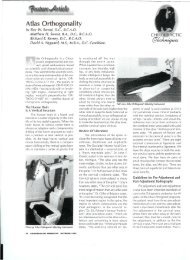The Ponticulus Posticus Pt. 2 - Atlas Orthogonal
The Ponticulus Posticus Pt. 2 - Atlas Orthogonal
The Ponticulus Posticus Pt. 2 - Atlas Orthogonal
You also want an ePaper? Increase the reach of your titles
YUMPU automatically turns print PDFs into web optimized ePapers that Google loves.
kinkingeffectupo9.~e vertebralartery<br />
withhead rotation . Indiscussingthe<br />
".followinginjuriesto the upper part of<br />
ponticulus, Ruth Jackson states that<br />
the cervicalspine, adhesions mayform<br />
betweenthe artery, the firstnerve root,<br />
and the bony arc~ or canal through<br />
whichthey pass".<br />
In our study, notes were kept of<br />
patients' two major complaints upon<br />
entrance.<br />
Possible symptoms of cerebrovasculardiseaserepresented<br />
25.9 percent<br />
of the entrance complaintsof the<br />
patients in our study, but neuromuscularcomplaintsfar<br />
outweighed those of<br />
circulationin nature. Neck, back, brachial,<br />
and lumbo-sacralcomplaints totaled<br />
68.1 percent. This figure !s<br />
probably influenced<br />
due<br />
to the practice<br />
being chiropractic,<br />
but is<br />
still very significant<br />
when<br />
compared to<br />
other complaints<br />
(see<br />
Table 2).<br />
Symptomatic<br />
I response<br />
to<br />
minimalforce<br />
vectored cervicaladjustments<br />
was<br />
veryfavorable<br />
in the 189<br />
cases with<br />
only 8.5 percent not responding. No<br />
adverse response was indicated.<br />
<strong>The</strong> reduction factors from the<br />
adjustmentof the 65 bilateralcomplete<br />
ponticulae compared to the reduction<br />
factorsof 100 post x-raysselectedrandomlybutwithoutponticulaeindicated<br />
13.8 percent less reduction when the<br />
bilateralbony arch was present. This<br />
suggests that the ponticulus posticus<br />
may restrictthe atlas in its abilityto be<br />
adjustedtowards normal.<br />
We propose that the effects of<br />
the passage of the first cervicalnerve<br />
through the arcuate foramen of atlas<br />
are and can be more detrimental than<br />
the effects of vertebral artery embarrassment,<br />
especiallyin the presence of<br />
adhesions, much in the same waythat<br />
A;AlJ-<br />
migration of the cervical spine in any<br />
direction can traction cervical nerves<br />
and~use symptomsof nerve root irritation<br />
. Very possibly,the symptoms of<br />
vertebro-basilarinsufficiencywere 9lleviated<br />
by Ercegovacand Davidovic by<br />
the elimination of adhesions irritating<br />
the firstcervicalnerve root or the inadvertent<br />
alterationsinthe juxtapositionof<br />
the atlas vertebra.<br />
In Figure 1, we see the complete<br />
unilateral x-ray view of the ponticulus<br />
posticus. In Rgure 2, the complete<br />
bilateralviewis presented, while in Figure<br />
3, the incomplete ring is shown.<br />
Conclusions<br />
<strong>The</strong> common occurrence of 18.9<br />
percent of the patients exhibitingponticulusposticusexemplifiesthe<br />
need for<br />
INCIDENCE OF 232 ENTRANCE COMPI.AlNTS/<br />
189 PATIENTS EXHIBITING PONTICULUS<br />
POSTICUS<br />
&ck Pain (Dorsal, Lumbar, Sacral) 84 or 36.2%<br />
Headache, Vertigo, Diplopia 60 or 25.9%<br />
Neck, Brachial Symptoms 55 or 23.7%<br />
Hip, Leg Pain 19 or 08.2%<br />
Tension, Hyperactivity, Insomnia,<br />
High Blood Pressure 10 or 04.3%<br />
Respiratory Illness ; 04 or 01.7%<br />
TABLE 1<br />
OCCURRENCE OF PONTICULUS POSTICAE AS<br />
VlSUAUZED RADIOGRAPHlCAU.Y<br />
BllATERAL<br />
Complete, Both Rings<br />
Incomplete, Both Rings<br />
One Complete, One Incomplete<br />
UNILATERAL<br />
Complete Ring<br />
Incomplete Ring<br />
65 or 34.5%<br />
22 or 11.6%<br />
18 or 09.5%<br />
47 or 24.8%<br />
37 or 19.6%<br />
radiographic study previous to any cervical<br />
manipulation. Correction of the<br />
atlas seems to be restricted in the presence<br />
of a bilateral ponticulus posticus,<br />
although symptomatic response is<br />
good. Forceful traction or rotary-type<br />
manipulations seem contraindicated as<br />
both the first cervical nerve and vertebral<br />
arteries are encased and surrounded by<br />
a bony mass as opposed to muscular or<br />
ligamentous soft tissue.<br />
Lamellar patterns within bone<br />
matrix and an obvious c~ex indicate<br />
endochondrclipssification and support<br />
Hayek's .view that the posterior pontide<br />
derives from the embryonic tissue<br />
of the dorsal arch of the pro-atlas. Although<br />
the posterior atlanto-occipital<br />
membrane is indeed a ligament, it is<br />
Photos: Gary B... and Keith Crowe<br />
Fig. 1: Lateral view of atlas ponticulus posticus.<br />
Fig. 2: Unilateral incomplete ponticulus posticus.<br />
Fig. 3: Above: Human atlas with bilateralponticulus postiOlS.<br />
Below: Raccoon atlas viewed at same angle.<br />
Note formaen in neuroarch for first cervical nerve.<br />
Fig. 4: Unilateral ponticulus posticus with axis vertebra.<br />
Fig. 5: Bilateral ponticulus posticus with axis.



